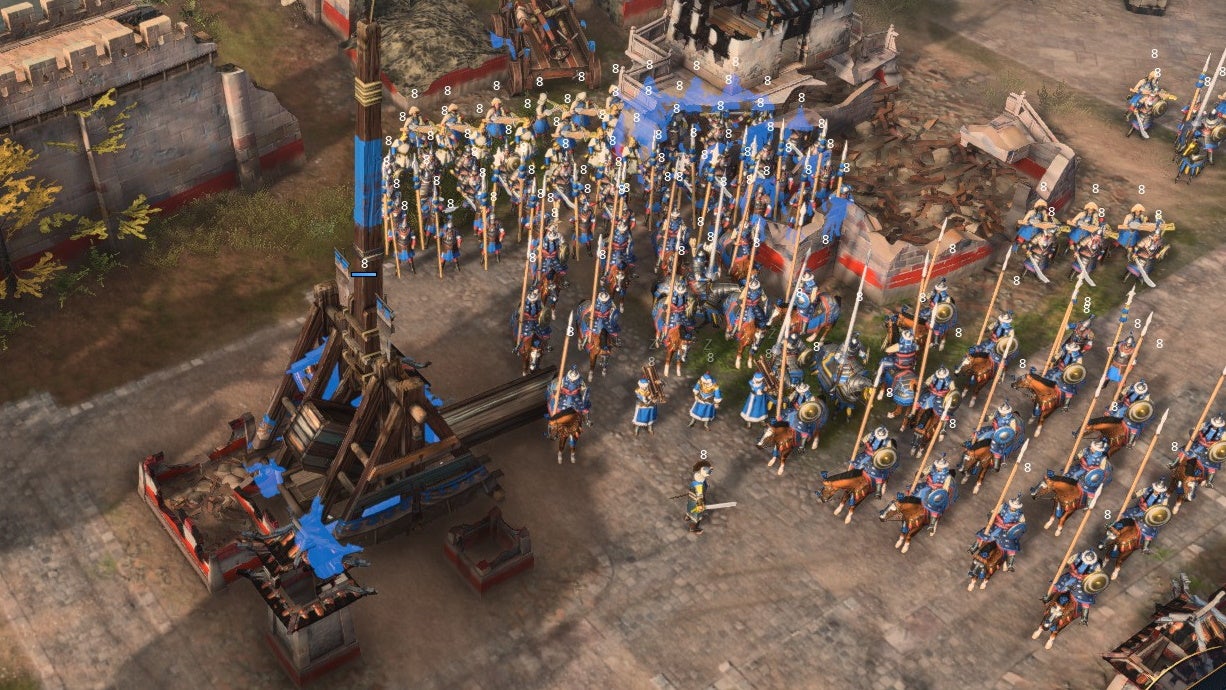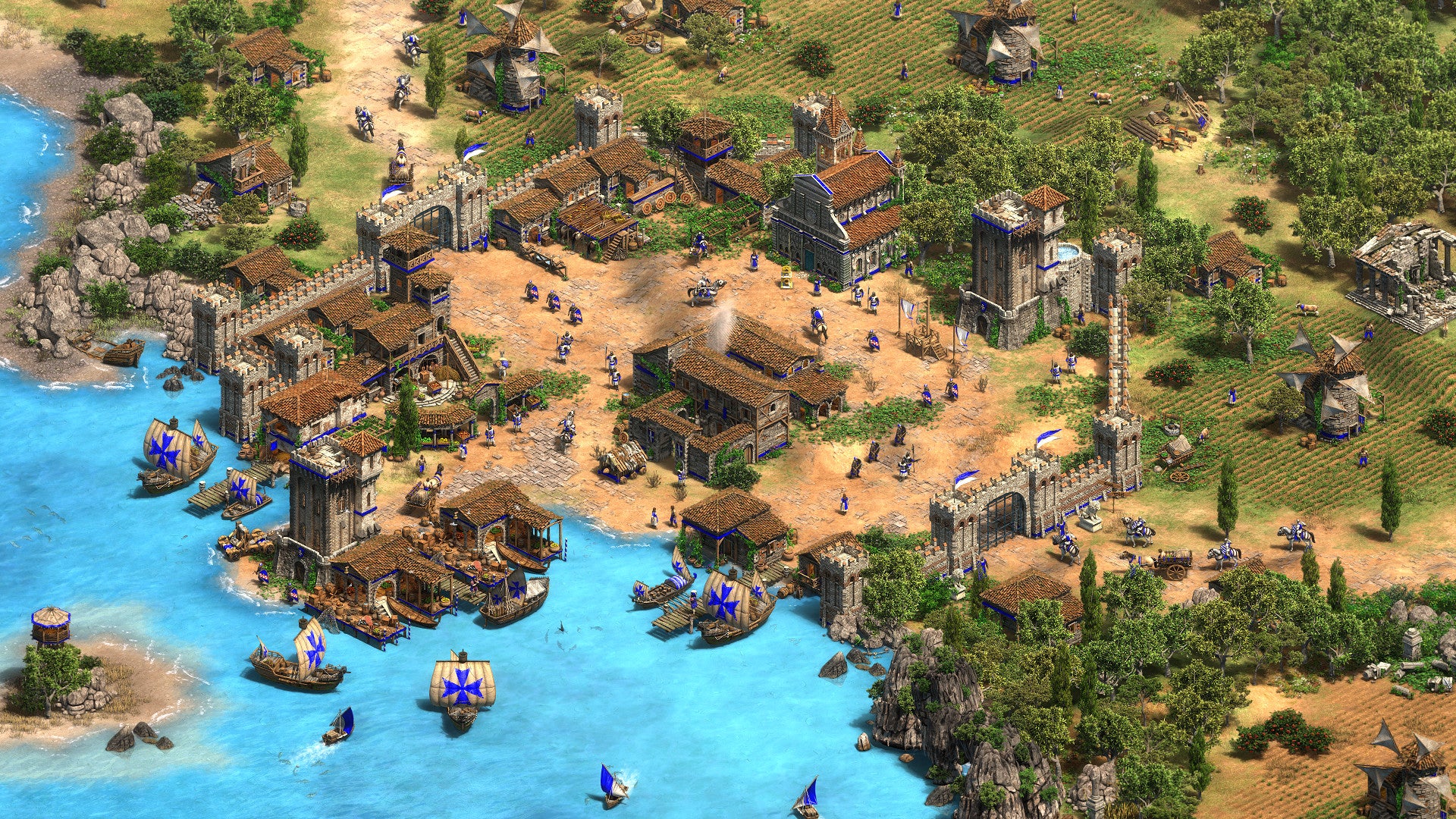To Isgreen, it’s this level of accessibility that’s carried Age Of Empires all the way to today’s 25th anniversary. The instantly legible historical warfare - “pikemen, ranged units and cavalry” - paired with randomised maps that promised, effectively, an infinite amount of replayability; “It just had a lot of features that I think players really loved and kind of defined itself along those features in a way that, yeah, it’s just outlasted everything else.” “Really it comes down to, the players are the beating heart of the franchise,” says director of customer voice Emma Bridle. “It’s really special that a lot of us who work on Age Of Empires are fans who played it as kids - you know, at college LAN parties - who are now taking that franchise forward. It’s been driven by players all over the world who’ve never stopped playing the games for 25 years, even when new titles weren’t coming out. They were still playing, they were still self hosting tournaments. They were still creating mods.” It’s also key that these games tell the stories they do, says Bridle. With so many cultures represented, there’s always an entry point, no matter where you grew up. And from there, you can learn about others. “I’ve heard stories, we’ve got a player who said, ‘Well, I grew up in Europe. So I knew Joan of Arc. I knew William Wallace. I never got to know our Asian history, that it’s not taught at school. But I got to explore it through Age of Empires, discover this love.’" That player is now a history teacher. Bridle herself remembers playing the first AOE alongside learning about Egyptians in school. They have players on every continent, and developers on every one too - except Antarctica, although Bridle jokes that you never know what could happen in the next 25 years. It’s a gift for any series of games to have such a dedicated community of players and modders carrying its torch, even during release droughts. But it does present a problem to solve. How do you make things exciting again for a community that’s so used to playing their own way? How do you bring years of player feedback back around for a remaster, Definitive Edition, or even a whole new game? “There’s a point where you reach where it’s kind of a blurred line between who owns the game,” says Isgreen. “Is it the community that owns the game? If we’re not making a new game and they’re modding and doing all kinds of cool stuff, they’re owning the game. And then we come back and like, hey, here’s some new stuff.” From day one, says Isgreen, the goal has been to involve the community in anything they did. At one point, AOE4 used a completely different resource model, alongside other experimental features. Isgreen remembers flying a bunch of the community to Relic studios to gauge their reactions. “What do you think about this? Will it work? Will it not? Is it too far away from Age? We were always really worried about making something that wasn’t Age of Empires-ish. It’s always been hand in hand with the community, especially the Definitive Editions. We didn’t want to break the magic.” “We really look to how people had been playing the game whilst new titles weren’t coming out,” adds Bridle. “Looked at the features they used heavily, and the ways that they wanted to play. I tried to ask for stats on how many changes we made. And just in a pre-release environment, across the Definitive Editions, it was thousands of changes.” Bridle mentions a Kenyan journalist who spoke to her about AOE3’s African Royals DLC, saying that she could hear her language in a video game for the first time. “And that’s really meaningful. There’s so many places we can take AOE, but we do it in partnership with the community. They tell us if we’re getting it right, if we’re on the right track, if we’re ready to go. They have that seat at the table with us.” Community feedback remains crucial to the ongoing development of the series, but keeping the series’ identity also means adhering to a few core pillars. The first of these, says Isgreen, means keeping things human. “We’re centred on telling the human story. Human is people, it’s inventions, it’s technology. It’s everything that humans have either done or created or imagined, right? It’s the idea that we are centred on people, and because of that, we want it to be relatable to people and authentic in how we portray them.” The next pillar, says Isgreen, is Global. “You have to recognise it and then be inclusive to all of these different cultures and peoples and be respectful in how you portray them,” he explains. “That’s been a big push of ours, is to make sure that you know all of our representation is respectful to those cultures, even as sometimes the definitions of what is and is not of a culture shifts, and that can be challenging.” “The third one is Impactful,” Isgreen continues. “We want to generate exciting content. We want to make something that’s interesting that catches your attention, which is why we took a very different approach to the narrative and the hands on histories and everything with Age 4. We wanted to kind of refresh the way that we were looking at telling stories.” Finally, there’s the fourth pillar - ‘Enlightening’. “We want to be like, darn it, you’re going to learn something! Even if you didn’t want to, maybe you learn something about history,” says Isgreen, comparing the team to a “super excited history teacher” who wants to be relatable, and show how fascinating humanity can be. But Age Of Empires is still an RTS at the end of the day - and one with no small competitive scene. Bridle says they’ve been adding things to the Definitive Editions and Age Of Empires 4 to make things easier for players coming to the genre for the first time. Today’s Anniversary update also adds ranked team matches to AOE4, which Isgreen says is a great way to start trying ranks, but with friends rather than going it alone. The same 25 years of an evolving meta that might make some potential players nervous to dive in, can also be a boon. “There’s so many fantastic pro players creating content,” Bridle says. “There’s 25 years of wisdom out there, and the community is very generous with sharing their love of the game, and their own strategies.” “The 25 years, it’s documented,” adds Isgreen. “There’s a wealth of information on meta, ways to play, how to micro these units. That said, I think we could do better.” No-one, says Isgreen, has quite made the perfect RTS in terms of accessibility, one that’s known as being easy to get into. “We think about the different ways in,” says Bridle, “What can make someone think, ‘Oh RTS or strategy gaming is for me?’” They think a lot about how to welcome new players, whether with learn-to-play guides on the official website, or mentoring in the Discord. “We’re 25 years in, but the franchise is growing. And so it’s: How do we not only have the door open to those new players, but make sure there’s a space for them and something for them as they join the community?” The next 25 years might be slightly too ambitious of a roadmap, but what do the next few years look like for Age Of Empires? Isgreen brings it around to those core pillars again. Telling the story of people doesn’t just mean replicating history to the letter. Anywhere people go, or have gone, offers the team fertile ground to explore. “Originally it was: Age has gotta be just authentic history. But mythology comes around and like, oh wait! That’s a human byproduct of religions and the past. That’s amazing. There could be something like that,” he says. “The cool thing there is, then you can start to say, well, if humans can imagine it or do it or it’s part of us, then that’s also part of Age Of Empires. So it gives us a lot of ground to play with in terms of the future. Of what we might do, or where we might go” For the more immediate future, there’s that 25th anniversary update, of course. “There’s some fun stuff coming,” says Bridle. “Even some of the event rewards that we’ve got lined up are drawing inspiration from 25 years of like, memes and in-jokes. And there’s some really, really fun stuff there that I can’t wait to start using. We’re gonna be excited to see what resonates with the players.” Alongside other updates, it brings two new civilisations to the game - the Ottomans and the Malians. When it came to designing these new additions, says Isgreen, he took inspiration from the old Westwood days. “I have this saying that everyone on my creative team knows: players should feel like they’re cheating. That you’re getting away with something. That everyone else is angry because they can’t do that.” Even though it’s actually all balanced, the player should have the sense they’re pulling a fast one. When they were working on the Ottomans, and the Malians especially, the team started thinking about their trade wealth. “And I’m like, what if they taxed? What if we felt like they were cheating every time they put up an outpost and anyone drove by that outpost with a trader, they took some of the money? I think the most fun has been pushing the civs further and further into, like, interesting ways that they feel cheaty, but they’re not.” This is where it links back to Westwood. “There’s a line you gotta walk. It’s kind of like Red Alert, right? We couldn’t make every unit wacky because then nothing would feel wacky, right? You’ve got to find that fine line.” I bring up Tanya, Red Alert’s dual wielding, C4 planting heroine, and Isgreen’s own tribute, he says, to John Woo films. “We’ll probably be pulling a little more Westwood philosophy into our games as we go into the future, just in terms of making sure that we always have that kind of crazy amount of goofy enjoyment that you can get out of them. And however we can manifest that through Age - not that we’re going to change Age.”


